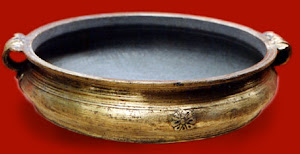Ammi:
 The ammi pictured left was used to make pastes. For example, coconut gratings might be put at one end, water added in small quantities and the round stone was rolled over the material to turn them into a paste.When spices like chillies and ginger were added to the cocount, the resulting paste would be a chutney.
The ammi pictured left was used to make pastes. For example, coconut gratings might be put at one end, water added in small quantities and the round stone was rolled over the material to turn them into a paste.When spices like chillies and ginger were added to the cocount, the resulting paste would be a chutney.Wet Grinder:
making iddali or dosa paste. Rice and water were put in the cup and the heavy stone worked round and round by hand to convert it into a liquid paste. Next urad dal and water were converted into paste similarly. The two pastes were mixed and fermented overnight to make the mixture that was the raw material for iddali and dosa.
The Hand Mill:
 The hand mill (pictured left) seems to be one item that is yet to have a modern version. It is used to split dals like black gram and green gram. After splitting and soaking, it becomes quite easy to remove the husk and process the dals. Split and soaked black gram is ground to a liquid dough for iddali and dosa. Split green gram is used as an ingredient in curries. The hand mill could also be used to granulate grains.
The hand mill (pictured left) seems to be one item that is yet to have a modern version. It is used to split dals like black gram and green gram. After splitting and soaking, it becomes quite easy to remove the husk and process the dals. Split and soaked black gram is ground to a liquid dough for iddali and dosa. Split green gram is used as an ingredient in curries. The hand mill could also be used to granulate grains.Cooking was done in mud pots over an open fire (see pic right).  Three stones placed at three corners supported the pot above the fire.
Three stones placed at three corners supported the pot above the fire.
 Three stones placed at three corners supported the pot above the fire.
Three stones placed at three corners supported the pot above the fire. Varpu:



No comments:
Post a Comment